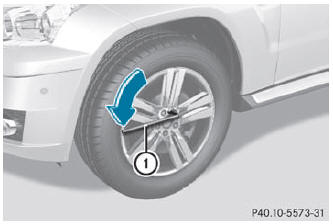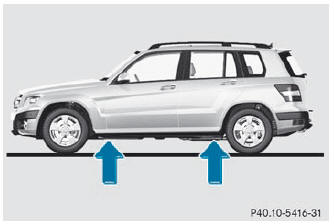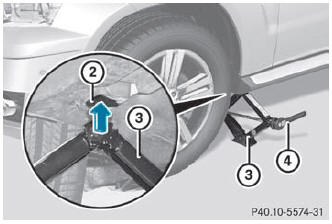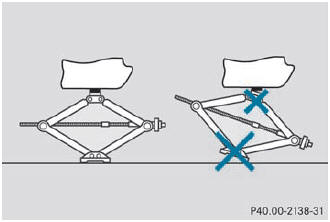Raising the vehicle
![]() WARNING
WARNING
When jacking up the vehicle, only use the jack which has been specifically approved by Mercedes-Benz for your vehicle.
The jack is designed exclusively for jacking up the vehicle at the jacking points built into both sides of the vehicle. The jack saddle must be placed centrally under the jacking point. The jack must always be vertical when in use, especially on inclines or declines.
The jack is intended only for lifting the vehicle briefly for wheel changes. It is not suited for performing maintenance work under the vehicle. To help avoid personal injury, use the jack only to lift the vehicle during a wheel change.
Never get beneath the vehicle while it is supported by the jack. Keep hands and feet away from the area under the lifted vehicle. Always lower the vehicle onto sufficient capacity jackstands before working under the vehicle.
Always firmly engage the parking brake and block the wheels with wheel chocks or other sizable objects before raising the vehicle with the jack. Do not disengage the parking brake while the vehicle is raised.
Make sure that the ground on which the vehicle is standing and where you place the jack is solid, level and not slippery. If necessary, use a large underlay. On slippery surfaces, such as tiled floors, you should use a non-slip underlay, for example a rubber mat. Do not use wooden blocks or similar objects as a jack underlay. Otherwise, the jack may not be able to achieve its load-bearing capacity if it is not at its full height. Never start the engine when the vehicle is raised.
Also observe the notes on the jack.

- Using lug wrench 1, loosen the bolts on the wheel you wish to change by about one full turn. Do not unscrew the bolts completely.
The jacking points for the jack are located behind the wheel housings of the front wheels and in front of the wheel housings of the rear wheels (arrows).

![]() WARNING
WARNING
The jack is designed exclusively for jacking up the vehicle at the jacking points. The jack saddle must be placed centrally under the jacking point.
If you do not position the jack correctly in the jacking point, the vehicle can fall off the jack and seriously or fatally injure you or others.
![]() The jack is designed exclusively for jacking up the vehicle at the jacking
points. Otherwise, your vehicle could be damaged.
The jack is designed exclusively for jacking up the vehicle at the jacking
points. Otherwise, your vehicle could be damaged.
- Take the ratchet wrench out of the vehicle tool kit and place it on the hexagon nut of the jack so that the letters AUF are visible.

- Position jack 3 at jacking point 2.

- Make sure that the base of the jack is positioned directly under the jacking point.
- Turn ratchet wrench 4 until jack 3 sits completely on jacking point 2 and the base of the jack lies evenly on the ground.
- Turn ratchet wrench 4 until the tire is raised a maximum of 1.2 inches (3 cm) off the ground.
See also:
Before changing a fuse
► Park the vehicle and apply the parking
brake.
► Switch off all electrical consumers.
► Remove the SmartKey from the ignition
lock.
The fuses are located in various fuse boxes: ...
Underinflated tires
WARNING
Follow recommended tire inflation pressures.
Do not underinflate tires. Underinflated tires
wear excessively and/or unevenly, adversely
affect handling and fuel economy, and are
more ...
Rim
This is the part of the wheel on which the tire
is mounted. ...
